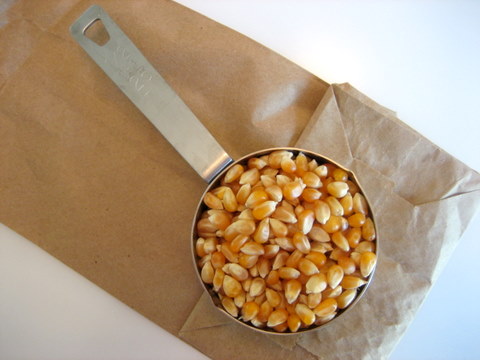AARP Hearing Center
Microwave Popcorn's Health Problem: It's In The Bag
By Candy Sagon, March 22, 2012 08:00 AM

Every day at 4 p.m., like clockwork, one of my co-workers makes a bag of microwave popcorn.
We all can hear it popping and then, of course, the fake-buttery aroma permeates the office, which invariably causes someone to ask -- "Isn't that stuff bad for you?"
Actually, it's not popcorn, per se, that people should be worried about. It's the microwave bag in which it cooks that many experts say is the problem.
Popcorn itself is healthy. It's a whole-grain food, high in fiber and antioxidants and, if not doused in fat, a pretty low-cal snack.
The problem is the chemicals used in the lining of the bag, including perfluorooctanoic acid (PFOA).
PFOA is also used to make Teflon and other stain- and stick-resistant materials, including pizza boxes. It's part of a number of compounds that have caused liver, testicular and pancreatic cancer in animals. The chemicals may also be linked to infertility in women, according to a recent study at the University of California, Los Angeles.
Earlier this year, a study found that these chemicals may prevent childhood vaccinations from working properly. Children who had higher concentrations of the chemicals in their blood had a lower level of protection against some childhood diseases for which they had been vaccinated.
The chemicals in the bag lining get into our bloodstream because they vaporize and migrate into the popcorn during microwaving, said Olga Naidenko, a senior scientist for the Environmental Working Group. "They stay in your body for years and accumulate there," she told Prevention magazine for an article titled, "7 Foods That Should Never Cross Your Lips."
While scientific research has not established a link between microwave popcorn bags with PFOA and increases in cancer in humans, the chemical is so pervasive that it's detectable in the blood of 95 percent of Americans.
Popcorn with artificial flavoring is also a concern. A few years ago, microwave popcorn was slammed for the use of diacetyl in its artificial butter flavor, which caused a rare type of lung disease among workers who inhaled it at microwave popcorn factories.
Most manufacturers have removed diaceytl from their products, but it's been replaced with other kinds of butter flavoring that some government scientists say are just as bad as the original stuff.
Even the top lawyer for the flavoring industry has said that "these so-called substitutes are diacetyl."
So what's a popcorn lover to do?
Make your own microwave popcorn, says cookbook author and longtime food writer Mark Bittman.
Bittman first wrote "Microwave popcorn, minus the ripoff," for the New York Times in 2008. His no-brainer idea to microwave kernels in a brown paper lunch bag was so popular, he did a repeat last year on his website.
Now, obviously, you can make popcorn the old-fashioned way, by popping it with some oil in a heavy, covered pot. Or you can use this clever stovetop gizmo with the wonderful name of Whirley Pop.
You can also find glass microwave popcorn poppers online or in some cookware stores, if you want to skip using dead-tree bags.
But if you're at the office or lazy (like some of us), here are Bittman's microwave popcorn instructions:
Mark Bittman's Microwave Popcorn:

(Makes 2 to 4 servings). In a small glass container, or a brown paper lunch bag, combine 1â„4 cup popping corn with 1â„4 teaspoon salt and fold the top of the bag over a couple of times (some people tape it shut). Microwave on high for 2 to 3 minutes, until there are 4 or 5 seconds between pops. Open the bag or container carefully, because steam will have built up. Toss with your seasonings and a drizzle of butter or olive oil or serve as is.
You can add oil to the bag at the beginning if you like, but this will yield a slightly greasy bag (so - you use a bowl). And of course you can top the finished product with melted butter or any spice you want. This enables you to have microwaved popcorn but with your choice of popcorn and oil, and, if you were to make popcorn daily, to save hundreds of dollars a year. At every supermarket in the country, microwave popcorn sells for at least $4 a pound and usually closer to $6. Ordinary popcorn is about $1 a pound, or less; good organic popcorn is about $2 a pound.
In other health news:
Less invasive hernia procedure offers less pain, faster recovery. Hernia surgery that uses the newer technique of laparoscopy through a small opening results in less chronic pain and a faster recovery when compared to the traditional approach that involves a two-inch incision in the groin, reports HealthDay. However, laparoscopy must be performed under general anesthesia, while the older approach can be done with a local anesthestic, making the older one more appropriate for patients with multiple health problems, doctors said.
How about a face lift for your hands? Dermatologists are now offering aging hands a "hand lift" -- injecting fillers to plump up the thinning skin on the back of the hand and using lasers to resurface the skin and remove brown spots. These kinds of cosmetic procedures have helped women's face look younger, so now "hands are the new hot area," says one New York dermatologist.
A cheap drug saves bleeding victims, but there's too little profit in it for companies. A New York Times story says a simple, generic drug that has been saving lives on battlefields by slowing the bleeding of gravely wounded soldiers -- and could do the same for victims of car crashes or other emergencies here -- is having a tough time getting into American hospitals. The drug, tranexamic acid, is so inexpensive, there's little profit in making it, so drug companies don't.
They're calling it "Marmageddon." New Zealand is reeling from a shortage of its beloved breakfast spread, Marmite. The dark, sticky, yeasty product, which is rich in B vitamins but definitely an acquired taste, is made by only one factory, which has been shut down since last year's earthquake. The company hopes to resume production by July, but in the meantime, enterprising citizens are even selling already-opened jars of Marmite for top prices. (New Zealanders favor their domestic Marmite to its Aussie cousin, Vegemite, although Americans might not be able to tell the difference -- or want to eat either of them.)
Photo credit: (top) home-ec101.com; (bottom) squawkfox.com































































